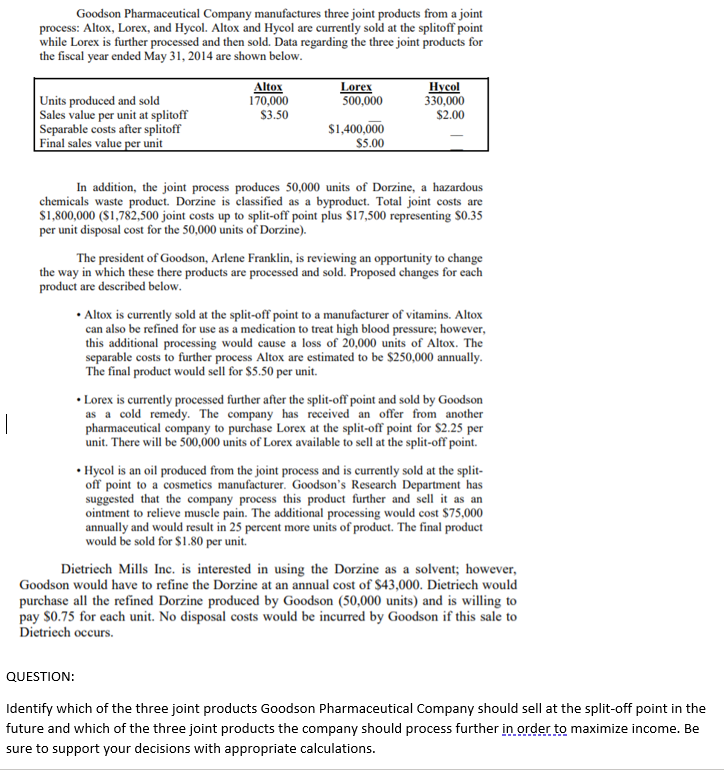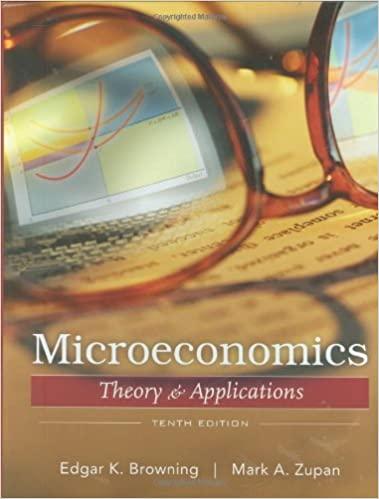Question
Sales value per unit at splitoff $3.50 __ 2.00 Separable costs after splitoff $1,400,000 __ Final sales value per unit $5.00 __ In addition, the

Sales value per unit at splitoff $3.50 __ 2.00
Separable costs after splitoff $1,400,000 __
Final sales value per unit $5.00 __
In addition, the joint process produces 50,000 units of Dorzine, a hazardous chemicals waste product. Dorzine is classified as a byproduct. Total joint costs are $1,800,000 ($1,782,500 joint costs up to split-off point plus $17,500 representing $0.35 per unit disposal cost for the 50,000 units of Dorzine). The president of Goodson, Arlene Franklin, is reviewing an opportunity to change the way in which these there products are processed and sold. Proposed changes for each product are described below.
Altox is currently sold at the split-off point to a manufacturer of vitamins. Altox can also be refined for use as a medication to treat high blood pressure; however, this additional processing would cause a loss of 20,000 units of Altox. The separable costs to further process Altox are estimated to be $250,000 annually. The final product would sell for $5.50 per unit.
Lorex is currently processed further after the split-off point and sold by Goodson as a cold remedy. The company has received an offer from another pharmaceutical company to purchase Lorex at the split-off point for $2.25 per unit. There will be 500,000 units of Lorex available to sell at the split-off point.
Hycol is an oil produced from the joint process and is currently sold at the splitoff point to a cosmetics manufacturer. Goodsons Research Department has suggested that the company process this product further and sell it as an ointment to relieve muscle pain. The additional processing would cost $75,000 annually and would result in 25 percent more units of product.
The final product would be sold for $1.80 per unit. 4 Dietriech Mills Inc. is interested in using the Dorzine as a solvent; however, Goodson would have to refine the Dorzine at an annual cost of $43,000. Dietriech would purchase all the refined Dorzine produced by Goodson (50,000 units) and is willing to pay $0.75 for each unit. No disposal costs would be incurred by Goodson if this sale to Dietriech occurs
QUESTION:
Identify which of the three joint products Goodson Pharmaceutical Company should sell at the split-off point in the future and which of the three joint products the company should process further in order to maximize income. Be sure to support your decisions with appropriate calculations.
Goodson Pharmaceutical Company manufactures three joint products from a joint process: Altox, Lorex, and Hycol. Altox and Hycol are currently sold at the splitoff point while Lorex is further processed and then sold. Data regarding the three joint products for the fiscal year ended May 31, 2014 are shown below. Altox 170,000 $3.50 Lorex 500,000 Hyeol 330,000 $2.00 Units produced and sold Sales value per unit at splitoff Separable costs after splitoff Final sales value per unit $1,400,000 $5.00 In addition, the joint process produces 50,000 units of Dorzine, a hazardous chemicals waste product. Dorzine is classified as a byproduct. Total joint costs are $1,800,000 ($1,782,500 joint costs up to split-off point plus $17,500 representing $0.35 per unit disposal cost for the 50,000 units of Dorzine). The president of Goodson, Arlene Franklin, is reviewing an opportunity to change the way in which these there products are processed and sold. Proposed changes for each product are described below. Altox is currently sold at the split-off point to a manufacturer of vitamins. Altox can also be refined for use as a medication to treat high blood pressure; however, this additional processing would cause a loss of 20,000 units of Altox. The separable costs to further process Altox are estimated to be $250,000 annually. The final product would sell for $5.50 per unit. Lorex is currently processed further after the split-off point and sold by Goodson as a cold remedy. The company has received an offer from another pharmaceutical company to purchase Lorex at the split-off point for $2.25 per unit. There will be 500,000 units of Lorex available to sell at the split-off point. Hycol is an oil produced from the joint process and is currently sold at the split- off point to a cosmetics manufacturer. Goodson's Research Department has suggested that the company process this product further and sell it as an ointment to relieve muscle pain. The additional processing would cost $75,000 annually and would result in 25 percent more units of product. The final product would be sold for $1.80 per unit Dietriech Mills Inc. is interested in using the Dorzine as a solvent; however, Goodson would have to refine the Dorzine at an annual cost of $43,000. Dietriech would purchase all the refined Dorzine produced by Goodson (50,000 units) and is willing to pay $0.75 for each unit. No disposal costs would be incurred by Goodson if this sale to Dietriech occurs. QUESTION: Identify which of the three joint products Goodson Pharmaceutical Company should sell at the split-off point in the future and which of the three joint products the company should process further in order to maximize income. Be sure to support your decisions with appropriate calculations. Goodson Pharmaceutical Company manufactures three joint products from a joint process: Altox, Lorex, and Hycol. Altox and Hycol are currently sold at the splitoff point while Lorex is further processed and then sold. Data regarding the three joint products for the fiscal year ended May 31, 2014 are shown below. Altox 170,000 $3.50 Lorex 500,000 Hyeol 330,000 $2.00 Units produced and sold Sales value per unit at splitoff Separable costs after splitoff Final sales value per unit $1,400,000 $5.00 In addition, the joint process produces 50,000 units of Dorzine, a hazardous chemicals waste product. Dorzine is classified as a byproduct. Total joint costs are $1,800,000 ($1,782,500 joint costs up to split-off point plus $17,500 representing $0.35 per unit disposal cost for the 50,000 units of Dorzine). The president of Goodson, Arlene Franklin, is reviewing an opportunity to change the way in which these there products are processed and sold. Proposed changes for each product are described below. Altox is currently sold at the split-off point to a manufacturer of vitamins. Altox can also be refined for use as a medication to treat high blood pressure; however, this additional processing would cause a loss of 20,000 units of Altox. The separable costs to further process Altox are estimated to be $250,000 annually. The final product would sell for $5.50 per unit. Lorex is currently processed further after the split-off point and sold by Goodson as a cold remedy. The company has received an offer from another pharmaceutical company to purchase Lorex at the split-off point for $2.25 per unit. There will be 500,000 units of Lorex available to sell at the split-off point. Hycol is an oil produced from the joint process and is currently sold at the split- off point to a cosmetics manufacturer. Goodson's Research Department has suggested that the company process this product further and sell it as an ointment to relieve muscle pain. The additional processing would cost $75,000 annually and would result in 25 percent more units of product. The final product would be sold for $1.80 per unit Dietriech Mills Inc. is interested in using the Dorzine as a solvent; however, Goodson would have to refine the Dorzine at an annual cost of $43,000. Dietriech would purchase all the refined Dorzine produced by Goodson (50,000 units) and is willing to pay $0.75 for each unit. No disposal costs would be incurred by Goodson if this sale to Dietriech occurs. QUESTION: Identify which of the three joint products Goodson Pharmaceutical Company should sell at the split-off point in the future and which of the three joint products the company should process further in order to maximize income. Be sure to support your decisions with appropriate calculationsStep by Step Solution
There are 3 Steps involved in it
Step: 1

Get Instant Access to Expert-Tailored Solutions
See step-by-step solutions with expert insights and AI powered tools for academic success
Step: 2

Step: 3

Ace Your Homework with AI
Get the answers you need in no time with our AI-driven, step-by-step assistance
Get Started


